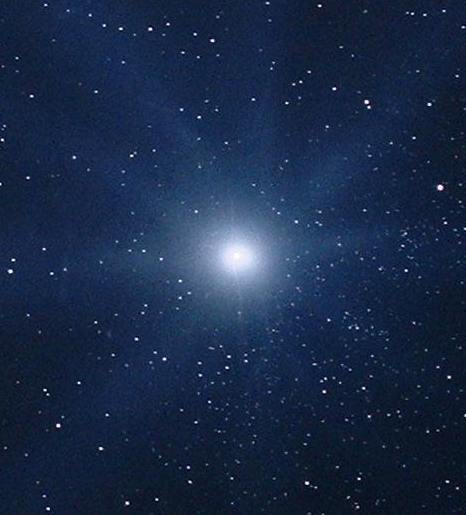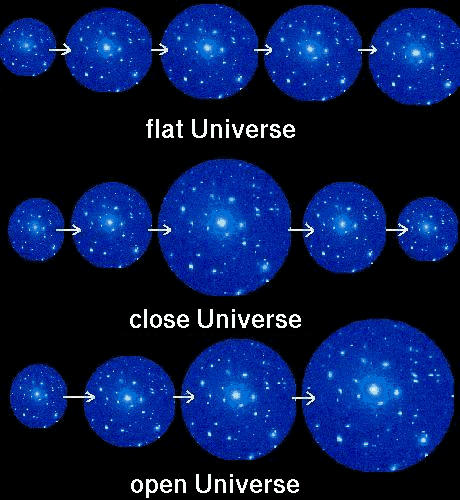What is dark energy?
- Transfer
You all probably heard this phrase: dark energy. But what is it, and why is studying it difficult? I'll start my story with a story.
Let's say you have a candle. You know all about it, including its brightness and distance to it. Here is this:

If I move the candle back to twice the distance, its brightness will have to decrease by 4 times. If I move it three times apart, its brightness will have to decrease by a factor of 9. If I move it back to the set distance, its brightness should decrease by a million times relative to the original.
But only in space, of course, there are no candles. But then there is a special class of events in which, as far as we know, there is an inherent brightness (with an accuracy of a few percent) throughout the Universe. This event is a type Ia supernova. When our Sun, and in general most of the famous stars, burn all the fuel, they eventually turn into white dwarfs. In this case, our Sun will consist mainly of carbon and oxygen, but white dwarfs sometimes contain helium, neon and silicon. Here is one of them:

There is only one star in our solar system. Many systems have two or more stars. If one of them is a white dwarf, it can start stealing a mass of others. In this case, it begins to grow. There is a critical mass limit that a white dwarf can hold before the atoms themselves begin to collapse. And when they collapse, it ends with an explosion so powerful that it is known as a type Ia supernova. The following animation shows an explosion simulation. Notice how the rest of the stars fly out of the star system due to a powerful explosion:
www.youtube.com/watch?v=t_-nkS3MdXI
Having seen these supernovae in different galaxies, we can measure their brightness, and, knowing the brightness inherent in them, we can calculate the distance to them. We can also measure their redshift. This information is enough to understand how the universe is expanding. You can present three options of what the Universe can do after the Big Bang. In the beginning, you have a huge amount of matter and energy expanding and scattering from each other, but gravity is trying to gather them together. This is what can happen:
There is so much matter and energy in the universe, and as a result, gravitational attraction, that gravity wins and can reverse the explosion, causing the universe to collapse into itself (closed universe)
There is not enough matter and energy in the Universe to overcome expansion, and the Universe continues to expand forever (open Universe)
There is just so much matter and energy in the Universe to be able to withstand expansion, without bringing the matter to collapse - only for the expansion rate to zero (flat universe).

Now looking at the supernovae, we will see what they tell us about what is happening. And you know what? The universe in general does not do any of the three things listed! It seemed to fit the model of a flat Universe for some time, but at some point the expansion rate stopped falling, and now it not only does not fall to zero, but also becomes a constant in the value of 85% of its current value. Why? Nobody knows. But there must be some kind of physics in this, and we gave it the name “dark energy”, because if the Universe were filled with a new type of repulsive energy, it would accelerate expansion. But this is a strange process, and it continues unambiguously, and we still do not know how to correctly explain it. That's what dark energy is!
Let's say you have a candle. You know all about it, including its brightness and distance to it. Here is this:

If I move the candle back to twice the distance, its brightness will have to decrease by 4 times. If I move it three times apart, its brightness will have to decrease by a factor of 9. If I move it back to the set distance, its brightness should decrease by a million times relative to the original.
But only in space, of course, there are no candles. But then there is a special class of events in which, as far as we know, there is an inherent brightness (with an accuracy of a few percent) throughout the Universe. This event is a type Ia supernova. When our Sun, and in general most of the famous stars, burn all the fuel, they eventually turn into white dwarfs. In this case, our Sun will consist mainly of carbon and oxygen, but white dwarfs sometimes contain helium, neon and silicon. Here is one of them:

There is only one star in our solar system. Many systems have two or more stars. If one of them is a white dwarf, it can start stealing a mass of others. In this case, it begins to grow. There is a critical mass limit that a white dwarf can hold before the atoms themselves begin to collapse. And when they collapse, it ends with an explosion so powerful that it is known as a type Ia supernova. The following animation shows an explosion simulation. Notice how the rest of the stars fly out of the star system due to a powerful explosion:
www.youtube.com/watch?v=t_-nkS3MdXI
Having seen these supernovae in different galaxies, we can measure their brightness, and, knowing the brightness inherent in them, we can calculate the distance to them. We can also measure their redshift. This information is enough to understand how the universe is expanding. You can present three options of what the Universe can do after the Big Bang. In the beginning, you have a huge amount of matter and energy expanding and scattering from each other, but gravity is trying to gather them together. This is what can happen:
There is so much matter and energy in the universe, and as a result, gravitational attraction, that gravity wins and can reverse the explosion, causing the universe to collapse into itself (closed universe)
There is not enough matter and energy in the Universe to overcome expansion, and the Universe continues to expand forever (open Universe)
There is just so much matter and energy in the Universe to be able to withstand expansion, without bringing the matter to collapse - only for the expansion rate to zero (flat universe).

Now looking at the supernovae, we will see what they tell us about what is happening. And you know what? The universe in general does not do any of the three things listed! It seemed to fit the model of a flat Universe for some time, but at some point the expansion rate stopped falling, and now it not only does not fall to zero, but also becomes a constant in the value of 85% of its current value. Why? Nobody knows. But there must be some kind of physics in this, and we gave it the name “dark energy”, because if the Universe were filled with a new type of repulsive energy, it would accelerate expansion. But this is a strange process, and it continues unambiguously, and we still do not know how to correctly explain it. That's what dark energy is!
